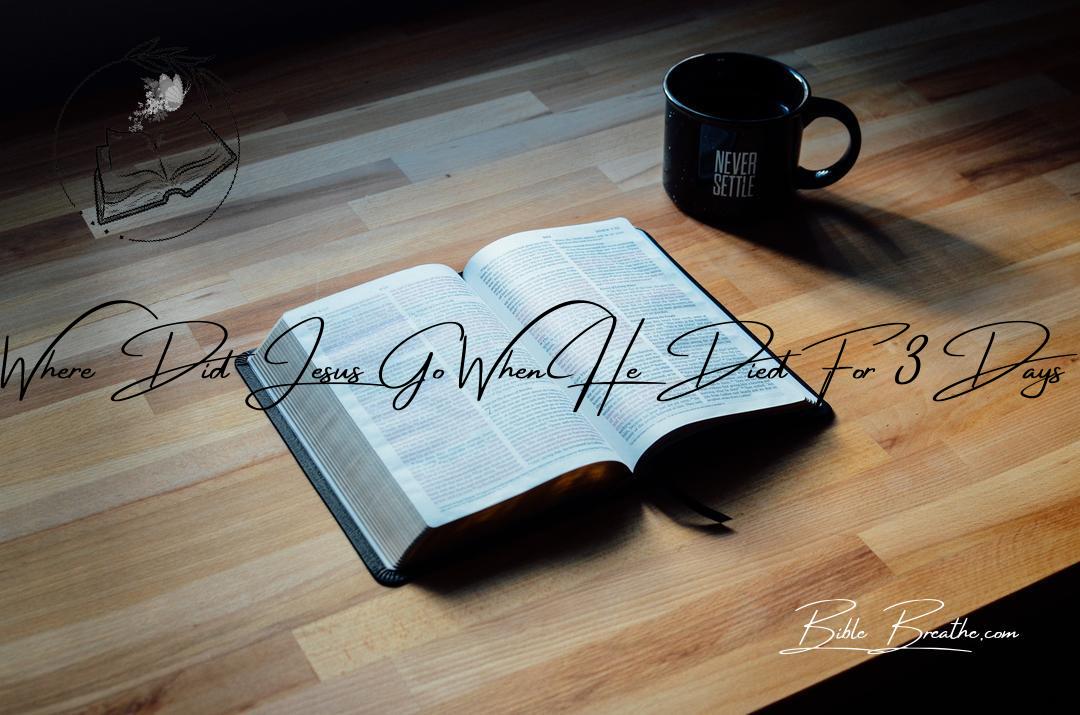Where did Jesus go when He died for 3 days?
Now, that’s a question that’ll make your spiritual curiosity skyrocket, just like a rocket on a mission!
Picture this: Jesus on the cross, the ultimate showdown of good versus evil.
But what went down during those three mysterious days?
You see, it’s like a journey through a maze – from the cross to the depths of Hades and the heights of Paradise.
Imagine Him preaching to those who crossed paths with Noah back in the day.
It’s like a divine rescue operation!
These three days, they hold the key to redemption, the ultimate comeback story.
Think of it as a superhero rising from the ashes, because when Jesus ascended, it was a spiritual triumph like no other.
Faith, salvation, heaven, and hell – they’re all part of this cosmic battle.
So, come along on this ride through the Gospel, the tomb, and the scriptures.
We’re about to decode the mystery of those three days and the victory that echoes through time.
🌟
Key Takeaways
- Understanding the context of biblical passages is crucial when exploring where Jesus went when He died for three days. The Bible does not provide explicit details about this period, requiring careful consideration of related scriptures.
- Jesus’ three days in the tomb hold immense significance in Christian faith. It marks His descent into the realm of the dead, a key aspect of His redemptive work. This event is linked to the Christian belief in the resurrection and the triumph of life over death.
- The question of where Jesus went during those three days has been the subject of theological discussions and interpretations throughout Christian history. It highlights the depth and complexity of biblical teachings, encouraging believers to delve into scripture and theology to gain a richer understanding of their faith.
- Ultimately, the mystery surrounding where Jesus went during those three days underscores the need for continuous exploration and study of scriptures. It reminds Christians of the profound nature of their faith and the ongoing journey of discovery and spiritual growth that it entails.
The Enigmatic Journey of Jesus After His Crucifixion

Photo modified by BibleBreathe.com. Original photo by Mathias Reding on Pexels
My friends, have you ever wondered where Jesus ventured during those three mysterious days following His crucifixion?
It’s like a captivating chapter in the grand story of our faith, filled with divine triumph and the promise of salvation.
Jesus’ Final Moments and the Cross
Picture this: The sky turned dark, the crowd fell into a hushed awe, and there was Jesus, hanging on the cross.
He spoke words that still echo through time:
“It is finished.” – John 19:30 (KJV)
These words weren’t just ordinary words; they carried a cosmic weight.
They signified the completion of His earthly mission, the atonement for all our sins, and the glorious victory over death itself.
His Resting Place in the Tomb
As His life slipped away, they gently placed His lifeless body in a tomb.
This tomb, a silent witness to the greatest drama of redemption, cradled the Savior’s body.
It was like a quiet cave, a place of stillness and solitude, where His body would find rest for three days.
But what about His spirit during this time?
The Bible hints at His descent into the depths of Hades, a place both of captivity for some and a realm of waiting, much like the story of Noah’s flood and the deliverance of the righteous.
The Journey into the Abyss
Imagine this: Jesus, in His divine and intricate nature, descended into the depths, declaring victory to those held captive and making a path for the righteous souls of old.
Think of it like a triumphant conqueror entering a defeated city, proclaiming liberty to the captives.
He, the conqueror over sin and death, announced His victory over the forces of darkness and sin.
His journey through Hades wasn’t a defeat; it was a declaration of triumph and redemption.
As He walked through those spiritual realms, His presence and power resonated, echoing through the ages.
In this enigmatic journey, Jesus shattered the gates of captivity, paving the way for the ultimate victory – His resurrection and the promise of eternal life for all who would believe.
Stay tuned, my friends, for the next part of this series, where we’ll delve into Jesus’ triumphant resurrection and its profound implications for all of humanity.
Get ready to uncover the timeless truths of the Gospel!
Unlocking the Mystery: Where Did Jesus Go After the Crucifixion?

Photo modified by BibleBreathe.com. Original photo by Jaya Endean on Pexels
A Heart-to-Heart Amidst the Agony: Jesus’ Destination Revealed
As Jesus hung on the cross, enduring excruciating pain, a remarkable conversation unfolded between Him and a fellow condemned man.
Picture it: both in their darkest hour, and yet, a glimmer of hope emerged.
The thief, recognizing Jesus’ innocence, uttered these words: “Lord, remember me when thou comest into thy kingdom” (Luke 23:42, KJV).
And in response, Jesus offered a promise that gives us insight into His immediate post-crucifixion whereabouts.
The Promise of Paradise: A Beacon of Comfort
In the midst of agony, Jesus spoke words of solace: “Verily I say unto thee, Today shalt thou be with me in paradise” (Luke 23:43, KJV).
These profound words reveal that after His crucifixion, Jesus embarked on a journey to a place often referred to as “paradise,” offering reassurance to the repentant thief.
The Three-Day Wait: What Happened in the Tomb
After the crucifixion, Jesus’ body was laid to rest in a tomb, where it rested for three days.
But here’s the thing: His spirit and consciousness were far from idle.
The scriptures may not delve into intricate details of this period, but one thing is clear – it was a time of profound spiritual triumph.
To truly grasp the significance of these three days, we need to zoom out and see it in the grand tapestry of His mission: to defeat sin, conquer death, and open the door to redemption for all of us.
“O death, where is thy sting? O grave, where is thy victory?” – 1 Corinthians 15:55 (KJV)
Rising in Glory: Resurrection and Ascension
After a triumphant battle with death, Jesus emerged from the tomb, shattering the chains of mortality.
His resurrection wasn’t just a personal victory; it was the cornerstone of the Christian faith, a promise fulfilled.
In time, He ascended into heaven, sealing His eternal triumph over sin and offering the gift of salvation to all who believe.
Shedding Light on Jesus’ Three-Day Sojourn Beyond the Grave

Photo modified by BibleBreathe.com. Original photo by MART PRODUCTION on Pexels
Diving into the mysterious period between Jesus’ crucifixion and His triumphant resurrection is like peering through a heavenly peephole, revealing profound truths that have intrigued believers for ages.
The Enigmatic Scriptures: 1 Peter 3:18–20
In the scriptures of 1 Peter 3:18–20, we stumble upon a passage that has stirred extensive debate and pondering:
“For Christ also hath once suffered for sins, the just for the unjust, that he might bring us to God, being put to death in the flesh, but quickened by the Spirit: By which also he went and preached unto the spirits in prison; Which sometime were disobedient, when once the longsuffering of God waited in the days of Noah, while the ark was a preparing, wherein few, that is, eight souls were saved by water.” – 1 Peter 3:18–20 (KJV)
Deciphering Jesus’ Proclamation to the Imprisoned Spirits
This scripture paints a complex picture of Jesus preaching to captive spirits.
The interpretations vary, but a common thread suggests a significant happening during the days His body rested in the tomb.
Some believe Jesus proclaimed triumph over sin and death to the souls who had perished in Noah’s time.
Relating to Noah’s Time and the Great Flood
The mention of Noah’s era and the deluge in this passage draws a parallel between Noah’s deliverance and the redemption brought by Jesus.
Just as Noah and his kin found refuge in the ark, Jesus’ sacrifice becomes the path to salvation for all believers.
Varied Views: Demonic Spirits vs. Human Souls
Interpreting the essence of these “spirits in prison” differs among scholars and theologians.
Some hold that they were the souls of the wicked who perished in the flood, given an opportunity to hear the salvation message through Christ.
Others posit that these spirits were fallen angels, disobedient during Noah’s time.
Irrespective of the exact interpretation, the passage underscores the universal reach of Jesus’ sacrifice, extending hope and redemption across time and circumstances to all souls.
In our journey through Jesus’ extraordinary adventure during those three days, we peel back layers of divine purpose and compassion.
The forthcoming segments of this series will unravel more of this profound narrative, illuminating the depths of Christ’s victory and boundless love for humanity.
Stick around as we continue this expedition through the sacred scriptures.
Peering Into the Days Between the Crucifixion and Resurrection: Ephesians 4:8–10

Photo modified by BibleBreathe.com. Original photo by RDNE Stock project on Pexels
A Journey Beyond Death’s Grasp
Ever wonder where Jesus went during those three days after He bore the weight of the cross?
The book of Ephesians, in chapter 4, verses 8 to 10, gives us a glimpse into His actions in that unique timeframe.
Rising Up and Setting Captives Free
In Ephesians, we read about Jesus ascending and leading a procession of captives, bestowing gifts upon humanity.
This paints a beautiful picture of Jesus triumphing over death and liberating the souls held captive.
Conquering the Unseen Foe: Devil, Death, and Sin
During those mysterious days, Jesus engaged in a spiritual battle, conquering the very forces of evil — the devil, sin personified, and the sting of death.
His victory broke the chains that bound us, paving the way to salvation and eternal life.
This brief period, while shrouded in some mystery, was a crucial part of the grand story of redemption.
Jesus’ journey wasn’t aimless; it was a victorious mission, a purposeful laying of the foundation for the Christian faith and the promise of eternal redemption.
“And having spoiled principalities and powers, he made a shew of them openly, triumphing over them in it.” – Colossians 2:15 (KJV)
A Glimpse Into the Victory
Though we may not know every intricate detail of those three days, we’re assured through Scripture of Jesus’ spiritual triumph and the fulfillment of divine promises.
It showcases the depth of Christ’s love and His unyielding commitment to redeem mankind, giving hope and assurance to believers.
In the end, Jesus emerged victorious, shattering the chains of death and offering salvation and eternal life to all who place their faith in Him.
Unveiling the Beyond: What Happened During Jesus’ Three-Day Rest

Photo modified by BibleBreathe.com. Original photo by Mathias Reding on Pexels
Peering into the profound mystery of where Jesus ventured during the three days following His crucifixion is like gazing into the depths of eternity, a blend of scriptural certainties and the human quest to fathom the unfathomable.
Jesus’ Pledge to Paradise
In the midst of the excruciating crucifixion ordeal, Jesus spoke words that echo through the annals of time:
“Verily I say unto thee, Today shalt thou be with me in paradise.” – Luke 23:43 (KJV)
In this mighty declaration, Jesus comforted the repentant criminal beside Him, assuring them of a journey to a realm of bliss and comfort, a place of spiritual triumph for the redeemed by faith.
The Silence of Jesus’ Suffering in Hell
Contrary to certain beliefs, there’s no definitive biblical evidence supporting the notion that Jesus suffered in hell during those three days.
The focus of that period seems to revolve more around His proclamation of victory and liberation, rather than enduring torment.
The idea that Jesus descended into hell might stem from interpretations of verses like Ephesians 4:9, which speaks of Jesus descending to “the lower parts of the earth.” However, this likely refers to His descent to the realm of the departed, not a place of suffering.
Navigating the Bounds of Understanding
Unraveling the specifics of Jesus’ expedition during those three days requires a delicate balance between embracing the certainties offered by scripture and acknowledging the limits of human comprehension.
The Bible provides glimpses, not a complete panorama, inviting us to trust in the divine plan.
In the forthcoming part of our exploration, we will delve deeper into the truths encircling Jesus’ glorious resurrection and the profound impact it holds for believers.
Walk with us as we journey further into the heart of the Gospel narrative.
Frequently Asked Questions (FAQs) About Where Did Jesus Go When He Died For 3 Days
What does “paradise” mean in the context of Jesus’ conversation with the thief?
In this context, ‘paradise’ likely refers to a place of eternal bliss and communion with God, indicating the thief’s future salvation.
Did Jesus really visit hell or Hades?
The Bible does not provide clear evidence that Jesus visited hell or Hades during His crucifixion.
The idea of the ‘Harrowing of Hell’ is based on interpretation and tradition rather than explicit biblical texts.
While Jesus descended to the dead, the nature and purpose of this event are subject to theological debate.
How do different denominations interpret Jesus’ three days?
Various denominations interpret ‘Jesus’ three days’ differently.
For instance, some see it as the period between Jesus’ crucifixion and resurrection, while others view it as a metaphorical reference to stages of spiritual transformation or link it symbolically to Jonah’s time in the fish.
Interpretations can vary across denominations.
{
“@context”: “https://schema.org”,
“@type”: “FAQPage”,
“mainEntity”: [
{
“@type”: “Question”,
“name”: “What does “paradise” mean in the context of Jesus’ conversation with the thief?”,
“acceptedAnswer”: {
“@type”: “Answer”,
“text”: “In this context, ‘paradise’ likely refers to a place of eternal bliss and communion with God, indicating the thief’s future salvation.”
}
},
{
“@type”: “Question”,
“name”: “Did Jesus really visit hell or Hades?”,
“acceptedAnswer”: {
“@type”: “Answer”,
“text”: “The Bible does not provide clear evidence that Jesus visited hell or Hades during His crucifixion. The idea of the ‘Harrowing of Hell’ is based on interpretation and tradition rather than explicit biblical texts. While Jesus descended to the dead, the nature and purpose of this event are subject to theological debate.”
}
},
{
“@type”: “Question”,
“name”: “How do different denominations interpret Jesus’ three days?”,
“acceptedAnswer”: {
“@type”: “Answer”,
“text”: “Various denominations interpret ‘Jesus’ three days’ differently. For instance, some see it as the period between Jesus’ crucifixion and resurrection, while others view it as a metaphorical reference to stages of spiritual transformation or link it symbolically to Jonah’s time in the fish. Interpretations can vary across denominations.”
}
}
]
}

